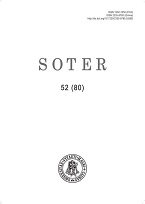M. K. Čiurlionio simfoninės poemos „Dies irae“ analitinės interpretacijos
Analytical interpretations of M. K. Čiurlionis’ symphonic poem “Dies irae”
Author(s): Yumiko Nunokawa, Darius KučinskasSubject(s): Christian Theology and Religion
Published by: Vytauto Didžiojo Universitetas
Keywords: M. K. Čiurlionis; „Dies irae“; Simfoninė poema; Religinė muzika M. K. Čiurlionis; “Dies irae”; Symphonic poem; Religious music
Summary/Abstract: Pirmą kartą mokslinėje literatūroje detaliai nagrinėjama simfoninės poemos „Dies irae“ genezė. Pateikiama teminė bei struktūrinė kūrinio analizė, nurodoma viduramžių sekvencijos ir dailininko Arnoldo Böcklino įtaka, atskleidžiami M. K. Čiurlionio kūrybos aspektai, susiję su lemties, amžinybės ir mirties klausimais. Daroma išvada, kad simfoninė poema „Dies irae“ yra visos M. K. Čiurlionio muzikinės kūrybos kulminacija, išsiskirianti visiškai nauju požiūriu į teminės medžiagos dėstymo, plėtojimo bei muzikinės dramaturgijos formavimo principus. The article is dedicated to analyse and newly evaluate one of the last M. K. Čiurlionis’ music compositions – the symphonic poem “Dies irae”. First of all, the role of liturgical sequence of the middle ages “Dies irae” is described in the context of Christian culture of Europe. Then the adaptations of the sequence in music of European composers (especially of romantic epoch) are presented. It is noted that the usage of “Dies irae” sequence in music compositions of Hector Berlioz, Ferenc Liszt and Sergei Rachmaninov was directly related to the idea of fatality, pain and death. One of the most typical examples is the Symphonic poem “preludes” by Liszt which embodies a philosophical view of Alphonse de Lamartine. Some aspects of Čiurlionis’ creative process related to destiny, eternity and death are revealed in this context. The influence of painter Arnold Böcklin to the formation of Čiurlionis’ philosophical views and its expression not only in painting but also in music is emphasized. The painting “Isle of the Dead” by Böcklin influenced many artists at the end of the 19 th century. Čiurlionis also admired Böcklin. He saw the painting “Isle of the Dead” for the first time in Leipzig, May 1902. It was the 5 th version of the painting (1886) with brighter-coloured sky and sea, slightly lacking the mournful serenity of the earlier versions. In the same year Čiurlionis listened to the Symphony No. 2 by Hans Huber and was left disappointed. This means that Čiurlionis was already well acquainted with many Böcklin’s paintings and felt the sense of it deeper than Hubert. Influence of Böcklin to Čiurlionis is seen in postcards he has sent to his brother Povilas – Čiurlionis has used not only reproduction of Böcklin’s “Prometheus” but also his own picture “Serenity” which is very similar to Böcklin in its composition and expressed mood. Cycle of paintings “Funeral symphony”, first part of tryptic “Rex” and painting “Night” are also influenced by Böcklin as it is described by art critics A. Savickas and V. Landsbergis.
Journal: SOTER: religijos mokslo žurnalas
- Issue Year: 80/2014
- Issue No: 52
- Page Range: 47-64
- Page Count: 18
- Language: Lithuanian

